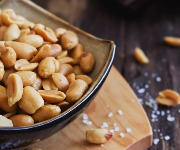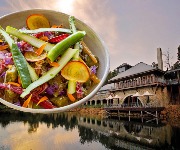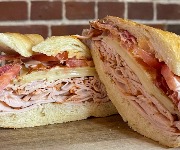Melton Mowbray style pork pie

The thing about pies from Melton Mowbray is that the pork must be fresh, not cured, chopped by hand (though it seems some mincing is allowed these days) and flavoured with anchovy essence as well as the more usual suspect: fresh sage. The pies from the best butchers are hand-raised, moulded by hand over a wooden pie mould called a coffin or coffer to make a free-standing pastry case, but there’s no shame in using a springclip tin.
You will need a 20–22cm/8–8.5inch springform tin.
Ingredients
- 1 kg boned shoulder of pork, bones saved for the stock
- 3 rashers of unsmoked back bacon
- 2 tsp chopped fresh sage
- 1 tsp anchovy essence or sauce
- 1 pinches of salt, pepper and grated nutmeg
- 250 ml well-flavoured jellied stock cold but liquid - To finish
- 2.2 lbs boned shoulder of pork, bones saved for the stock
- 3 rashers of unsmoked back bacon
- 2 tsp chopped fresh sage
- 1 tsp anchovy essence or sauce
- 1 pinches of salt, pepper and grated nutmeg
- 8.8 fl oz well-flavoured jellied stock cold but liquid - To finish
- 2.2 lbs boned shoulder of pork, bones saved for the stock
- 3 rashers of unsmoked back bacon
- 2 tsp chopped fresh sage
- 1 tsp anchovy essence or sauce
- 1 pinches of salt, pepper and grated nutmeg
- 1.1 cups well-flavoured jellied stock cold but liquid - To finish
Details
- Cuisine: British
- Recipe Type: Snack
- Difficulty: Hard
- Preparation Time: 30 mins
- Cooking Time: 120 mins
- Serves: 8
Step-by-step
- Cut about 300g of the meat into neat cubes of about 1cm, and very finely chop or mince the rest - don't use a processor. (You may find it easier to buy 300g lean pork, plus 700g good minced pork with around 20% fat.) Mince or finely chop the bacon.
- Put all the meat into a bowl with the sage, anchovy essence, a little salt, plenty of pepper and a few gratings of nutmeg. Mix the ingredients thoroughly.
- Take about a teaspoon of the mixture and fry it, like a mini-burger, then taste and adjust the seasonings, adding more salt and pepper, perhaps some more sage, as needed. The mixture should be tasty, not bland.
- If possible, cover the bowl and chill overnight for the flavours to develop. If not, cover while making the pastry.
- For the hot water crust pastry, follow the steps below and when cool enough to handle, cut off a third and keep for the lid.
- On a lightly floured surface roll out the larger piece of pastry to a circle large enough to line the base and sides of the tin. Lightly flour the surface of the pastry, then fold it in 4 and lift it into the tin.
- Unfold the pastry and press it on to the base and up the sides of the tin so it overhangs by about 2cm. Take care there are no cracks or holes. The pastry should be about 5mm thick.
- Pack the meat filling into the pastry case, making sure there are no pockets of air. Heat the oven to 200°C/400°F/gas 6.
- Fold the excess pastry neatly over the filling. Brush this rim with a little water.
- Roll out the remaining pastry to a circle to fit the top of the tin - cut round a plate to get a neat shape if necessary. Lift the pastry over the filling to cover, then press the pastry edges firmly to seal. Pinch the rim to neatly flute it.
- Make a large steam-hole in the centre of the pie and fit a small cylinder of foil into the hole to keep it open during baking.
- Brush with beaten egg, then set the tin on the baking tray and bake in the heated oven for 15 minutes.
- Reduce the oven temperature to 180°C/350°F/gas 4 and bake for a further 2 hours, covering the top of the pie with a piece of foil or greaseproof after an hour to prevent over-browning the crust.
- Leave to cool in the tin, then pour the cold stock into the pie through the foil tube. Chill overnight to set fully, then unmould, remove the foil, and serve at room temperature.
Additional recipe steps: Hot water crust pastry
This is a crisp, firm, robust pastry made and filled in the same way as the medieval pie crust called a coffin or coffer. From the fourteenth century, and perhaps earlier, cooks made tough flour and water pastes to wrap joints of meat to keep them moist during cooking. This paste, called a ciste in Wales, was chipped off after baking and discarded. Later, fat and spices were added to make the pastry edible. Hot water crust is quite distinct from our other methods of pastry-making; here the fat, lard or white fat, is melted with water (and often some milk), then mixed while still hot into flour and salt to make a smooth and pliable paste that can be rolled out or moulded or worked, by hand, rather like clay, to line or cover a mould. The pastry is strong enough to hold a compact meaty filling and absorb all the meat juices during baking. After baking and cooling, the filling usually contracts and the pastry case can be filled with cold stock to fill up the gaps left. It is usually eaten cold.
Ingredients
350g strong white plain flour
1 teaspoon salt
85g lard or white fat
185ml water (or half water and half milk)
beaten egg, to glaze
Steps
1. To make the pastry, sieve the flour, usually a good strong white flour (not the extra strong Canadian kind) or good-quality plain flour (not the very soft kind used just for cakes and sauces) and salt into a heatproof bowl.
2. Put the fat and water (or milk and water) into a pan and heat gently until the fat melts, without letting the mixture boil.
3. Pour into the centre of the flour and mix vigorously with a wooden spoon to make a soft, paste-like dough. Don't
worry if it looks a mess to begin with, it will come together as you beat.
4. Wait for the mixture to cool before rolling.
Additional recipe steps: How to make jellied stock:
To make a tasty stock that will set to a firm jelly is not difficult, but it does take some time. Put the bones from the meat used for the filling, plus a couple of pig's trotters (ask the butcher to split them), into a large pan with a large onion and carrot, roughly sliced, a good-sized bouquet garni (or a bay leaf) and a teaspoon of peppercorns. Add water, 2 or 3 litres, to well cover, then bring to the boil. Skim off any scum on the surface, then cover the pan and simmer gently for 4 to 5 hours. Strain the stock through a colander into a clean pan, discard the flavourings and boil the liquid rapidly until it has reduced down to about 750ml. Taste and season lightly. Leave to cool, then remove any fat on the surface. When chilled the stock should set, when you want to fill your cold pies it should be cold but still liquid.
Most Recent
Comments
Do you want to comment on this article? You need to be signed in for this feature








